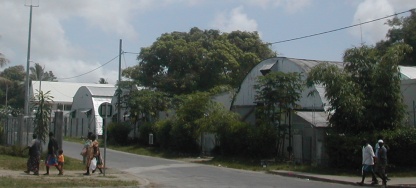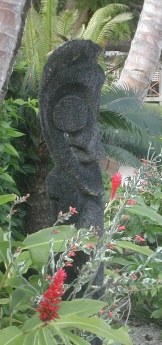ESPIRITU SANTO
Espiritu Santo is Spanish for ‘Holy Spirit’; however, this island is usually called just ‘Santo’. It is only 20 miles north of Malekula, and it is Vanuatu’s largest island.
Santo’s geography is highly varied. A mountainous spine runs along the west coast of the island, and Vanuatu’s four highest peaks – each over 5,500′ – are along that spine. Mount Tabwemasana – Vanuatu’s highest peak – is over 6,000′ elevation. The south and west is heavily wooded, and the south and east is relatively flat with much cattle grazing. There are numerous small islands off the southeast coast. Santo’s population is over 30,000, and most live in the southeastern part of the island which is also the location of Santo’s largest town – Luganville.
Santo, like much of Vanuatu, has its own bits of colorful local history. Two movements, in particular, are associated with Santo’s unique history.
In the 1920s, the Ronovoru Movement developed on Santo. Ronovoru was a local man who was particularly antagonist toward the Europeans living on Santo. He claimed that ‘the Europeans’ killed his wife, and his followers shared his antagonism. He also claimed that he could bring the dead back to life. However, when Ronovoru died, and he remained dead, his followers slowly faded into obscurity along with much of the antagonism toward Europeans.
In the 1960s, the Nagriamel Movement also developed on Santo. This movement was led by Jimmy Stevens, and its members sought for Santo to secede from then-New Hebrides. In 1980 – just eight weeks before independence – armed mainly with bows and arrows, Stevens’ followers occupied Luganville and declared Santo an independent nation which they renamed Vemarana. However, Stevens was arrested, order was restored, and the formal movement began to fade. Yet today, although the Nagriamel Movement has faded, the desire for secession persists among many.
However, Santo’s best known history emerges from World War II. The US military established a base on Santo, in Luganville, which supported the war efforts in the Solomon Islands. During the war, more than one half million allied troops passed through Luganville. There were often as many as 100 ships in the harbor, and a tremendous infrastructure was developed. Luganville continued to develop within that infrastructure.

Rows of quonset huts
Luganville is Vanuatu’s second largest town with a population of approximately 11,000. It is an entry/exit port for customs and immigration, so we chose it as our last stop in Vanuatu.
The town of Luganville is dominated by ageing remnants of the US military presence during World War II. Much of the shoreline is reinforced with disintegrating sheet pilings. There is a four-lane road even though there are few cars. There are countless corrugated metal quonset huts. Many are in disrepair, but many are still being used. There are numerous barracks. And a pizza restaurant even has the remnants of a huge airplane engine out in front to attract attention.
Luganville also has two banks, a small market, and a few shops along its main road. The market is relatively small, but it offers the usual selection of fresh produce in this area. The other shops are quite limited in their offerings.
Luganville does have a few dive shops. There is an active dive industry in Luganville which offers dives on various wrecks from World War II. The best known of these wrecks are the SS President Coolidge and Million Dollar Point.
The SS President Coolidge was a 663′ luxury liner that was refitted as a troop carrier during World War II. On October 26, 1942, she hit two ‘friendly’ mines just east of Luganville. The captain tried to run her aground, but she slipped back in to deeper water, and she slowly sank over the next 85 minutes. During those 85 minutes, all but two of more than 5,000 troops safely abandoned ship. Today she is the world’s largest wreck that is accessible to recreational scuba divers. Although accessible, this is a deep dive ranging from 69′ to 220′, so it is usually done only by experienced divers.
Million Dollar Point, on the other hand, is a shallow dive that can even be seen by snorkelers. At the end of the war, the US government wanted to sell its war surplus rather than transport it back to the US. It began negotiations with local planters and the condominium government, and the US government eventually offered this surplus for 8 cents on the dollar. The potential buyers held out hoping for an even lower price – or maybe for free. In frustration, the US government opted to dump the surplus in the ocean rather than give it away or transport it back to the US. Hundreds of tons of equipment was dumped – bulldozers, trucks, jeeps, food, etc. Today, that heap is a popular dive site.
Despite all that Luganville has, it lacks a decent anchorage. Its miserable anchorage has poor holding and no protection from the wind or current that runs through Segond Channel. Those intrepid souls that do brave the elements there find no way to land or secure their dinghy when they go ashore. Most choose to go across the channel to the moorings at Aore Island Resort. That is what we did.
Aore Island is a charming little island just over a mile across the Segond Channel from Luganville. Most of the island is cocoa or coconut plantations, and there are many bat caves. However, the Aore Island Resort is the draw for cruising boats. They have about ten moorings and a decent restaurant. They also offer a shuttle service five times daily across the channel to Luganville. They are welcoming to cruising boats, and they appear to want that business. They are not inexpensive, but they make Luganville convenient, and we were willing to pay a few dollars for that convenience.
We spent two weeks on a mooring at Aore Island Resort. We went to town a few times, and we went diving on the reef just off the island. We met a few new friends and spent time visiting with some old friends. We spent time getting Passage ready for the passage to Australia, and we mentally brought this cruising season to a close.
We usually both experience a ‘readiness’ to leave one place and head to another. Even in places that we have thoroughly enjoyed, we both eventually felt ready to move on. Not so with Vanuatu. This is the first place we have been that we did not experience that ‘readiness’ to leave. We really wanted more time here. But we were two weeks in to cyclone season, and we had already had a brush with Cyclone Xavier, so we knew we had to go – ready or not. We waited for our weather window, and we left mid-day on November 13.

Tree fern carving
Return to our Vanuatu page, come along on our sail to Australia, or jump ahead to our Australia page.